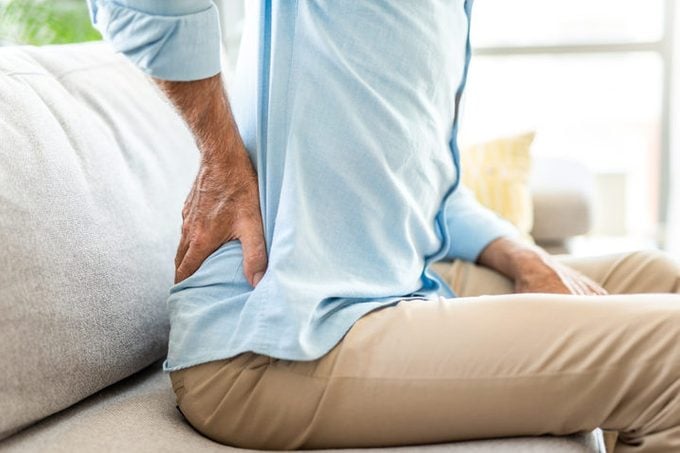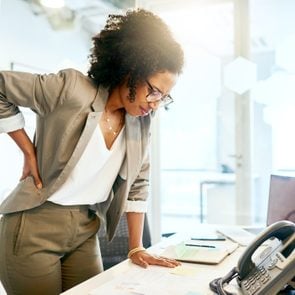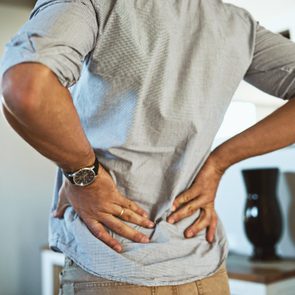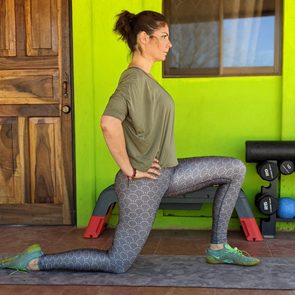What Causes Lower Back and Hip Pain?
Updated: Mar. 11, 2022
Lower back and hip pain can occur together due to various causes, from arthritis to pinched nerves. Figure out what happened—and find relief—with this expert info.
Causes of lower back and hip pain
Is the pain you’re feeling coming from your lower back, your hip, both, or maybe somewhere else entirely? It’s not always easy to tell. Lower back and hip pain often travel together, and it can be hard to figure out where the pain is coming from.
The lack of an obvious source for the pain makes sense because the hip bone is connected to the backbone (spine). But bones are just one of the structures in your back and hip that can cause pain. There are joints, tissue, muscles, nerves, ligaments, blood vessels, and discs too.
As a result, the list of potential causes of lower back and hip pain is long, overlapping, and varies by age, says Rahul Shah, MD, an orthopedic spine and neck surgeon with offices throughout New Jersey. Your risk for developing lower back or hip pain increases with advancing age, excess weight, and smoking, and the pain may be triggered by overexertion, falls, hormonal changes that leave bones more likely to crack, and other causes, he says. (Here’s how to increase your bone density.)
Here are a few possible causes of lower back and hip pain and the types of treatment available to alleviate the pain.
Arthritis
Osteoarthritis (OA), the wear-and-tear form of arthritis, can strike any joint in the body, but typically occurs in weight-bearing joints such as your hips or spine, according to the American Academy of Orthopedic Surgeons.
Causes
Your risk for OA increases with advancing age and/or excess weight and pressure on your joints, says Nikhil Jain, MD, a fellow in the department of neurosurgery at the University of Louisville in Kentucky.
Symptoms
Arthritis-related pain may occur across the back, into the side of the buttocks area, and sometimes even begin to trickle down the leg, Dr. Shah says. The pain may also hinder your ability to walk or participate in other activities. Arthritis of the hip commonly causes pain in the groin, too.
Diagnosis and treatment
Imaging tests along with a physical exam can help determine if OA or another type of arthritis is causing your hip or back pain. Your doctor will also consider your risk factors when making a diagnosis. If you are older and overweight, for example, it may tip the scale in favor of OA as opposed to another cause.
Blood tests are often needed to diagnose other forms of arthritis like ankylosing spondylitis (more on this later). Physical therapy and pain medications are first-line treatments for arthritis, but sometimes steroid injections or possibly joint replacement surgery may be warranted, Dr. Jain says.
Stress makes everything worse, including arthritis, lower back, and hip pain.
Herniated discs
Your lower back comprises five vertebrae (L1-L5), which are small bones that support your upper body. Shock-absorbing discs are found between each one, and these discs can slip, tear, shift, or degenerate.
Causes
Discs may herniate or rupture from poor posture, heavy lifting, twisting, bending, injury, falls, or advancing age, Dr. Jain says.
Symptoms
In addition to low back pain in the area where the disc is bulging or out of line, herniated discs may press on your nerves, causing sciatica, which can be felt in your hips too. (Also, beware of the silent signs of a slipped disc.) Sciatica is pain triggered by the sciatic nerve which runs from the lower back down the back of your legs all the way to your feet.
Diagnosis and treatment
Your doctor will examine you and ask detailed questions about your pain and when it first started, and order imaging tests to find out if your discs have shifted. Treatment usually involves pain medications and/or physical therapy. Sometimes bigger guns are needed, including steroid injections or surgery, Dr. Jain says.
Disc problems are very common, however, and don’t always cause symptoms. So sometimes a scan can lead to unnecessary surgery even if disc problems aren’t the true source of pain.
(Try these exercises for lower back pain.)
Spinal stenosis
When the space around your spinal cord narrows and puts pressure on the cord and your spinal nerves, it’s called spinal stenosis. Despite its name, spinal stenosis pain can also radiate and cause hip pain.
Causes
Advancing age is the greatest risk for developing spinal stenosis. This condition is most common in people older than 60.
Symptoms
Spinal stenosis doesn’t always cause symptoms but can cause pain and numbness down the legs with walking. (These are the everyday habits damaging your spine.)
Diagnosis and treatment
If your pain is indicative of spinal stenosis, your doctor will feel your back and may ask you to bend forward, backward, or side-to-side. Imaging tests can confirm a diagnosis. Treatment typically includes physical therapy and taking nonsteroidal anti-inflammatory drugs (NSAIDs) such as ibuprofen or naproxen to reduce pain and inflammation, followed possibly by steroid injections. Surgery is a last resort.
Sacroiliac joint dysfunction or pain
Your sacroiliac joint absorbs shocks between your upper body, pelvis, and legs.
Causes
There are lots of causes of sacroiliac joint dysfunction like falls on the buttocks, prolonged strenuous exercise, obesity, leg length discrepancy, and walking abnormalities, according to the American Academy of Physical Medicine and Rehabilitation.
Symptoms
If you strain or injure this joint, it can cause pain in your hip, back, and groin area, Dr. Jain says.
Diagnosis and treatment
Your doctor can diagnose sacroiliac joint dysfunction by conducting a physical exam and possibly ordering blood or imaging tests. Treatment may involve stretching exercises, and NSAIDs to relieve pain. Sometimes injections of steroids help cool inflammation. Working with a physical therapist can help.
Sprains and strains
There’s a difference between sprains and strains. A sprain is an injury or tear to a ligament that connects two or more bones at a joint. By contrast, a strain is an injury to a muscle or tendon. These can occur in your back or your hip.
Causes
You can develop strains or sprains in your hip or lower back after an injury or fall, after sudden twisting, bending, or lifting, or due to overexertion, Dr. Jain explains.
Symptoms
Strains and sprains may cause pain, swelling, bruising, cramping, spasms, and/or trouble moving.
Diagnosis and treatment
Your doctor will ask you questions about your pain and when it first started, examine the area and possibly order X-rays to rule out any broken bones.
Staying active, taking NSAIDs, and participating in physical therapy can usually help relieve pain stemming from strains and sprains. (These are the foods that fight inflammation and reduce pain.)
Pinched nerve
A pinched or compressed nerve in your lower back is known as radiculopathy. Sciatica is one form of radiculopathy.
Causes
This can occur if you have a slipped disc that is putting pressure on or pinching a nerve. It can also happen as a result of changes to your spine as you age such as spinal stenosis.
Symptoms
A pinched nerve may cause back, leg, and arm pain, weakness, tingling, or numbness.
Diagnosis and treatment
Your doctor will examine you and likely order imaging tests. The best way to see nerves in your spine is with an MRI. Treatment is based on the location of the nerve. Often, your doctor will suggest rest, NSAIDs, ice and heat, and/or physical therapy to improve your symptoms.
Tight hip flexors
Your hip flexors are located in the front of your hips. They help you move and flex your leg and knee.
Causes
In addition to becoming strained or sprained, your hip flexors can be tight, especially if you sit for extended periods of time at home or work.
Symptoms
Tight hip flexors can cause your lower back and hips to ache, according to the National Exercise Trainers Association.
Diagnosis and treatment
Your doctor will examine your range of motion and may order imaging tests to rule out other conditions. Treatment for tight hip flexors may include physical therapy or some gentle stretching exercises. (Here are 4 easy hip flexor stretches you can try.)
Ankylosing spondylitis
Ankylosing spondylitis is an inflammatory form of arthritis that strikes the sacroiliac joint, which connects your pelvis to your lower spine) and the cervical, thoracic and lumbar spine, says Dr. Jain.
Causes
Ankylosing spondylitis is an autoimmune disease that occurs when your body develops inflammation is the sacroiliac joint and other joints of the spine.
Symptoms
This condition is marked by flares of pain and stiffness in your hips and lower back, often followed by periods of remission, he says.
Diagnosis and treatment
Your doctor will conduct a physical exam and schedule imaging and blood tests to diagnose ankylosing spondylitis. In addition to NSAIDs, physical therapy, and possibly injections of steroids during flares, immune-modulating drugs that stop the inflammation cascade are sometimes used to treat ankylosing spondylitis.
Paget’s disease
This is a chronic bone disorder that occurs when your bones rebuild at a faster rate, according to the American College of Rheumatology. These new bones may be abnormal.
Causes
No one knows exactly what causes Paget’s disease but it may run in families and the soft, large, or otherwise abnormal new bone may cause pain in the area.
Symptoms
Paget’s disease can cause hip pain if it affects the pelvis or thighbone or back pain if it strikes in the spine.
Diagnosis and treatment
Your doctor will perform a physical exam and order X-rays to diagnose Paget’s disease. A bone scan may also be needed. Medications such as bisphosphonates may stop or slow down the progress of the disease. There are times when surgery is needed to treat complications of Paget’s disease, according to Medline Plus.
Other causes of back or hip pain
Sometimes back and hip pain may not be coming from that area at all. Referred pain from abdominal or pelvic organs such as the colon, kidney, ureter, bladder, or uterus may be the cause, Dr. Jain says. If your doctor suspects that the pain is coming from elsewhere in your body, he or she will likely order additional tests to track down the source.
(These are the causes of lower back pain in women.)
Lifestyle changes that can help
When it comes to lower back and hip pain, prevention is key. This starts with maintaining a healthy body weight to keep added pressure off of your joints. Engaging in regular physical activity will also keep your joints and muscles limber and bones strong as you age.
Foam rolling and stretching are also helpful for muscle tightness and soreness. Applying heat and/or ice to the sore area can also reduce pain, swelling, and inflammation.
“We develop a treatment plan to match your signs and symptoms, and this may also include education about pain,” Magel says. “In general, we take an active approach and have patients avoid bed rest and gradually resume activity as soon as possible,” he says. Acupuncture may also help.
The last word
If you are experiencing persistent back or hip pain, see a doctor to find out what’s going on. Your doctor will perform a physical exam and ask questions about the pain and when it first started. After that, imaging tests such as X-rays may be recommended.
Most of the time pain will improve with activity modifications, over-the-counter medications such as NSAIDs or stronger prescription medications, and physical therapy.






















